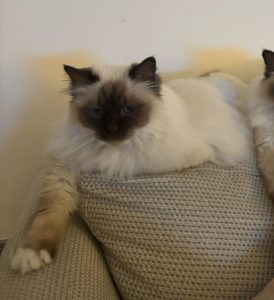 At Paws Indoors, we’re privileged to look after some truly remarkable pets —
At Paws Indoors, we’re privileged to look after some truly remarkable pets —
and Lily, a regal Ragdoll cat with bright blue eyes and a coat as luxurious as velvet, is no exception.
For the past twelve years, Lily has lived under the loving care of Mr and Mrs Turner. Recently, during a routine check-up, her story reminded us how subtle signs in a senior pet can reveal important health changes — and how early intervention, a proactive and responsible approach, can make all the difference.
The first clue: a matted coat
During Lily’s latest vaccination appointment, I noticed a few matts near the base of her tail. Mrs Turner explained that while Lily normally enjoys being brushed, she’d become sensitive about being touched in that area.
Until recently, she kept her coat in tip-top condition by herself, enjoying an additional brushing as more of a bonding activity than a necessity. Lily had always taken pride in keeping herself tidy. But something had changed.
Subtle signs of ageing
As Lily strutted around the kitchen, tail held high, I asked if there had been any other changes in her routine. Mr Turner mentioned she was no longer keen on venturing into the garden and couldn’t jump onto the kitchen counters like she used to. It was easy to assume this was “old age,” but these signs often tell a deeper story.
When I gently lifted Lily and examined her from nose to tail, I could feel the stiffness in her joints and the thinning of muscle on her limbs. Her walk confirmed it — she was no longer as agile, choosing to hop via the footstool to reach her favourite cushion on the sofa.
Ageing gracefully — with help
Understanding the real causes behind “old age”
Many owners dismiss stiffness, reduced activity, and weight loss in their senior pet as inevitable signs of ageing, but they are often symptoms of underlying conditions that can be treated.
Lily was not doing badly for her age, although a thorough check-up and blood test (which Lily stoically endured), discovered she was in the early stages of renal (kidney) disease. Her joints were also inflamed and painful, especially her elbows.
Starting the right support
We started Lily on a pain management plan that included joint supplements and medication. Mr and Mrs Turner also agreed to try a renal-friendly diet designed to support kidney function while still being palatable for cats. Lily wasn’t best pleased about this part but suffered in dignified silence.
One month on: a remarkable transformation
When I visited Lily a month later, the difference was astonishing. She could jump onto the sofa in one go again. Her playful spirit had returned, and she was patrolling the garden again. Best of all, the matts were gone — she was grooming herself again, pain-free. “I’ve got my princess back,” Mr Turner told me, beaming.
Although she was a bit choosy with the renal food (what Ragdoll isn’t?), her overall health and happiness had greatly improved.
A reminder to pet owners: regular check-ups matter
Lily’s story is a powerful reminder that older pets can thrive with the proper support. What seems like “just getting old” may be something treatable, which is great news!
Join our Pet Health Plan
I suggested to Mr and Mrs Turner that they enrol Lily into our pet health plan, as this would save them money on her regular visits to administer her injectable medication and that pets on the Vitality health plan also get an annual blood test included. Sorry Lily.
It’s a simple, affordable way to ensure your pet stays healthy and happy for years to come.
Is your senior pet slowing down?
Book a wellness check at pawsindoors.co.uk and let’s help them age gracefully, just like Lily.